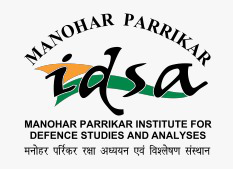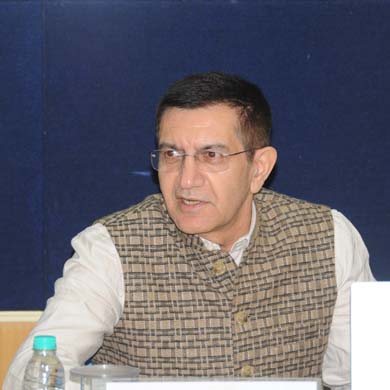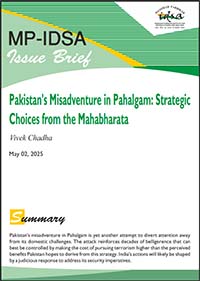Pakistan’s Misadventure in Pahalgam: Strategic Choices from the Mahabharata
- May 02, 2025 |
- Issue Brief
Issue-Brief-Col-Vivek-Chadha-02-May-2025
Introduction
On 22 April 2025, Pakistan was back to its familiar antics. Frustrated at the growing internal disenchantment with the ruling elite (Pakistan Army),[i] sectarian strife that threatens to engulf the society in flames[ii] and a weak economy surviving on external doles,[iii] the Pahalgam attack seeks a desperate external diversion in the face of domestic woes. It is yet another attempt at temporarily resuscitating the flagging fortunes of the “establishment”.
In essence, an incorrigible Pakistan will remain a nagging irritant—a role it has chosen for itself despite conventional wisdom suggesting otherwise.
Every major attack by Pakistan has predictably led to a debate around the options available to the Indian state. The punitive measures in 2016 after the attack at Uri and in 2019 after Pulwama reinforced the capacity and determination of the government to respond against terrorist infrastructure operating from Pakistani soil. Even as anger against Pakistan’s reprehensible action is justifiable and understandable, a state’s response is best guided by cold calculation to weaken Pakistan’s capacity to employ terrorism as an instrument of state policy. This is best guided by India’s national security imperatives and wisdom derived from the civilisational past.
The Mahabharata is one of the oldest texts that has guided Indian thought and action. It straddles spiritual guidance, philosophical thoughts and strategic insights, which are woven together through a gripping story. The epic has been passed down over centuries in different forms and ways. It remains one of the most popular texts with an intriguing perspective that continues to shape Indian thought. What does this epic say about dealing with a pernicious adversary? And are lessons derived from it still relevant for contemporary times? This Brief attempts to provide answers to these questions.
Philosophical Underpinning
The Mahabharata is anchored in the concept of dharma. Dharma can have several meanings that derive from its contextual use. Righteousness and duty emerge as more prominent references among others. Dharma, according to Bhishma,[iv] guides actions to “facilitate advancement and growth”, “uphold all creatures” and “restricting them from injuring each other”. Accordingly, one of the major pursuits of dharma is war avoidance.
Even as dharma’s objective remains the foundation of an ethics-based order, its derivatives help guide individuals in their personal and official capacities. Kshatriya dharma defines the role and responsibility of a soldier. Rajadharma guides a king. The core of this guidance requires a king to ensure yoga and kshema, in essence, the prosperity and protection of his subjects.[v] Interestingly, the Mahabharata considers rajadharma the highest form of dharma since it guides the welfare of the people, both economic development and safety from internal and external threats. Rajadharma remains a timeless concept since its constituent attributes remain similar. For modern states, the king is replaced by a democratic government with an elected leader at its helm.
India’s civilisational ethos suggests that a leader’s rajadharma prioritises war avoidance. Several instances reinforce this in the epic. One of the famous ones involves Krishna going as an emissary to Dhritarashtra’s court to broker peace when Duryodhana refuses to return their share of the kingdom after the Pandavas successfully complete their banishment in the forests. This results from Yudhishthira losing a game of dice, after which he is invited in a devious attempt at usurping their kingdom and possessions.
Krishna employs every element of diplomatic acumen, including sama (conciliation), dana (allurement) and bheda (dissension). He also uses coercion by extolling the martial qualities of the Pandavas and exhibiting his divine form to the gathering. Krishna goes to the extent of diluting their demand to a mere five villages instead of half the kingdom in an attempt to avoid war. Dhritarashtra, the king and his ministers accept his offer and the Pandava cause, except for Duryodhana and his coterie. This leads to a deadlock in negotiations, with war emerging as the only option for the Pandavas to seek justice.
Krishna’s experience suggests that maintaining peace with an incorrigible and dogmatic adversary may not always be feasible. Yet, diplomacy remains relevant for creating a moral advantage preceding the use of force. Despite failing to avoid war, Krishna convinces the majority of their cause and the righteousness of their claim. The war thus became a dharma yudhha—a conflict for a righteous cause. The concept of a dharma yudhha has subsequently been explained as just war with jus ad bellum and jus in bello as its constituents.[vi]
Dharma aims to create a just society through prosperity and peace. However, the desire for peace cannot guarantee it, unless a state maintains the ability to fight for it, if and when required. A sagacious leader must simultaneously retain a moral high ground. That facilitates the creation of a favourable opinion amongst decision-makers and states. It also allows greater flexibility of action. This will not stop a few from siding with the adversary. However, it will constrain their ability in the face of wider opposition.
The desire for peace and the use of force reflects a situational balance. When needed, the Mahabharata is unequivocal about using judicious force, even to the extent of waging war after exhausting all instruments of peace. The epic says that shying away from employing force when demanded by circumstances is adharma. Addressing Sanjaya, Dhritarashtra’s emissary, Yudhishthira says,
When there is time of calamity, those who do not act, or those who do not act correctly, are both reprehensible.[vii]
The repeated use of deceit, violence, injustice and humiliation by an adversary characterises such circumstances. As an illustration, Krishna resorted to severing Shishupala’s head after pardoning a hundred sins.[viii] Krishna had promised Shishupala’s mother that he would forgive a hundred sins of her son, even if these deserved death penalty. However, after that, he would face the consequences of his actions.
Did the war remain a dharma yudhha, with the Pandavas employing deception and deceit during the war to achieve their objectives? Jus in bello does demand such adherence during the conduct of war. Bhishma answers the query, often raised by those unable to reconcile his own death and that of Drona, Karna and Duryodhana. He justifies the use of adharma against adharma.
If the one who is fighting uses deceit, one may fight back using deceit. If he fights with adharma, one may counter him with adharma.
The Mahabharata’s guidance provides a fine balance between idealism and realism. It understands the reality of statecraft and the real-world responsibilities of a state. In doing so, the concept of rajadharma remains relevant in contemporary times.
Contextualising the aforementioned to Pakistan suggests that India did indeed go to great lengths to reconcile issues. This is evident from a series of historical examples, though a few recent ones reinforce reality. The Kargil intrusion was already underway when the Lahore Bus peace initiative by the then Prime Minister Atal Bihari Vajpayee was taken in February 1999. This was an attempt by the Indian Prime Minister to build bridges and eventually seek normalcy between the two neighbours. It was unknown to the seekers of peace that the preparations for stoking conflict from the Pakistani side were already underway. From the Pakistani side, “the first troops to cross the LoC did so in December 1998”.[ix]
It was a reminder that repeated friendly overtures would be rebuffed. Similarly, Prime Minister Narendra Modi’s outreach in 2014 received a setback due to relentless terrorism.[x] It became evident that the Pakistani ruling elite (read Pakistan Army) needed a constant distraction to justify their pampered standing within the country and backroom driving in the name of an existential threat from India. India’s logic of refusing to negotiate with terrorism as the currency of dialogue should therefore be seen in this context.
With Pakistan having crossed the threshold of international norms of behaviour, the events justify using all available means against their adharma. There cannot and should not be remorse in hitting Duryodhana to help eliminate adharma. It needs to be reinforced that the Mahabharata might not be considered by some as a dharma yudhha, given the use of deception. However, this suggests missing the woods for the trees. In an environment where the adversary unashamedly and unabashedly resorts to adharma, Krishna’s approach to the war was a dharma yudhha. India’s determination to end Pakistan’s use of terrorism as an instrument of state policy should also be seen in the same light.
India’s approach has also placed it on a higher moral plane. This is evident from the support received after previous terrorist attacks. It is yet again seen from the reactions emanating from most major capitals. Tulsi Gabbard, the US Director of National Intelligence, said, “We are with you and support you as you hunt down those responsible for this heinous attack.”[xi] Within a few days of the incident, India received widespread support for its position on the attack. Conversely, even Pakistan’s all-weather friends find openly supporting their ally difficult. The creation of a diplomatically conducive environment will facilitate India’s response. This includes action against terrorist leaders, camps, infrastructure and supporters.
The state’s rajadharma requires the protection of the people. The principle of judicious force gives it the flexibility to employ the most appropriate instrument to achieve the desired objective.
Making of a Strategic Response
Assessing Krishna’s actions in the Mahabharata provides insight into his strategic decision-making process. This process commences with identifying the nature of the threat and its implications. Before the war, Jarasandha posed a potential challenge to the conduct of the rajasuya and the crowning of Yudhishthira as an emperor.[xii] Jarasandha was a powerful king and the option of open war with him raised uncertainties of victory. During the war, Bhishma, Drona, Karna and eventually Duryodhana could have stalled the achievement of the Pandava war aims. In each case, the threat was analysed to determine its potential impact on their endeavour. Vulnerabilities were identified, and force was applied to achieve the desired results.
In Jarasandha’s case, it was considered prudent to enter his kingdom in disguise and challenge him to a wrestling match instead of waging a war. Deception was employed against the others to seek advantage in combat. Shikhandi, a woman in the previous birth, was deployed against Bhishma, knowing of his inability to fight the individual. Disinformation was applied against Drona by alluding to his son’s death. Karna was hit when dismounted from his chariot against the rules of combat. In each case, the individual in question was punished for their individual acts of adharma or for being active supporters of a side that fought for an unjust cause. Accordingly, the application of force varied to achieve the desired result, making it both a judicious and justifiable choice.
The handling of Pakistan should draw lessons from strategic thought derived from the Mahabharata. It is based on three core principles. One, an unbiased recognition of a threat/challenge. Two, an objective assessment of the options. Three, a judicious tool selection to derive the best results. Sama, dana and upeksha (indifference) have been employed. It is time to use bheda, maya (deceit) and danda (punishment).
The underlying principle for the action should be judicious force. An action that raises the costs just enough to undermine the leadership that repeatedly employs terrorism as a tool of choice. A finite and immediate end state does not define this response. Instead, the immediate finite action (read India’s response) is a subset of a wider infinite strategic competition, which should make the option of employing terrorism an irrational and uneconomical choice for the Pakistani “establishment”. Recent years suggest that India has expanded its strategic manoeuvre space even as Pakistan’s space has shrunk.
Therefore, the answer does not lie in seeking a sledgehammer blow. Instead, it demands a gradual squeeze with sama, dana, bheda, upeksha, maya and danda all contributing to the demands of a situation. Accordingly, the use of force is one tool that must be employed for the requisite effect in the proportion that it achieves the optimum results. Simultaneously, action on all other fronts must proceed to blunt Pakistan’s options.
It is not surprising to see Pakistan resort to strategic adventurism. The attack at Pahalgam reflects the actions of a desperate person indulging in backroom manoeuvring. This deserves a measured and judicious response. Kargil 1999 suggests India’s resolute stance will draw shrill doomsday scenarios from across the LoC, only to be replaced by equally shrill demands for the resignation of the Pakistani Army Chief when his gambit fails. The ends of a military response must go beyond its immediate impact. It should be yet another nudge for the fragile edifice to eventually crumble.
Views expressed are of the author and do not necessarily reflect the views of the Manohar Parrikar IDSA or of the Government of India.
[i] Yudhajit Shankar Das, “Pakistan Army’s Gym Rat Problem”, India Today, 18 March 2025.,
[ii] Sanjay Pulipaka, “On the Unrest in the Balochistan Region”, The Hindu, 26 August 2024.
[iii] “Pakistan: As Economic Woes Deepen, Citizens Continue to Struggle from Soaring Inflation, Unemployment Crisis”, The Economic Times, 15 September 2024.
[iv] Bhishma was the grand uncle to the Pandavas and Kauravas cousin brothers, hailing from the Kuru dynasty.
[v] A more detailed discussion of the term yogakshema will be taken up in a separate article.
[vi] While this Brief will not delve into the comparison of these concepts, the same will be taken up in detail in a forthcoming publication by the author.
[vii] Bibek Debroy, The Mahabharata, Vol. 4 (Translation), “Sanjaya-Yana Parva, Ch. 691(28)”, Penguin Random House India, New Delhi, 2011, p. 215.
[viii] Bibek Debroy, The Mahabharata, Vol. 2 (Translation), “Shishupala-Vadha Parva, Ch. 267(42)”, Penguin Random House India, New Delhi, 2010, p. 180.
[ix] Col Ashfaq Hussain, Witness to Blunder: Kargil Story Unfolds, Bookwise (India) Pvt. Ltd., New Delhi, 2013, p. 35.
[x] “PM Shreds Pakistan in Podcast, Says Every Peace Attempt Was Met With Betrayal”, India Today, 16 March 2025.
[xi] “Will Support India as It Hunts for Those Responsible for Pahalgam Attack: Tulsi Gabbard”, The Hindu, 25 April 2025.
[xii] Rajasuya was a ritual undertaken by kings. It involved seeking suzerainty from other rulers, culminating with the formal ceremony to anoint the king an emperor.






